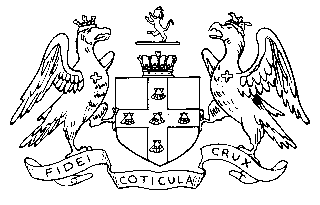

The title, 'Earl of Clarendon', was first borne in 1661 by Edward Hyde. He was born on February 18th 1608, at Dinton, near Salisbury, Wiltshire. Educated at Oxford, he became a barrister, and in 1640 was elected into Parliament. He objected to the constitutional acts of King Charles I, but remained loyal to the throne, becoming Chancellor of the Exchequer in 1643. After Charles' death, Hyde went abroad, and remained closely associated with The Royal Family. In 1658, King Charles II, made him Lord Chancellor, and from the Restoration he was made the King's Chief Adviser. Having made many enemies, he was forced to resign and went to France. Whilst in exile, Hyde wrote the "History Of The Great Rebellion". He died in Rouen on December 9th 1674 and is buried in Westminster Abbey.
The title remained in the family until 1753 when the 4th Earl died in December of that year. Six months earlier in April his only son had previously been killed when he fell off his horse on to the cobbles in Paris. There being no male members of the family left to inherit the title it did not pass on. The purchaser of The Grove, one Thomas Villiers, had married the heiress to the Hyde family. According to Cussans, "Villiers had been created Baron Hyde of Hindon, in the County Of Wiltshire, in recognition of his diplomatic services in Dresden, Vienna and Berlin. In 1776 he was raised to the dignity of Earl of Clarendon, and the title once more came into existence", According to Williams, in his definitive work "History of Watford", "The family crest became the eagle of Prussia (now part of Germany) and also incorporated the crest of King Frederick II of Prussia, as a mark of His Majestys esteem for him", He died on December 11th 1786 and is buried in Watford.
When The Grove was purchased in 1753, the building was referred to as an Elizabethan House. Who had the house built has been another source of confusion amongst historians. Some credit Francis Heydon with this distinction, whilst others refer to it as having been carried out by Lord Doneraile. What is known, is that prior to Lord Doneraile acquiring the estate in 1743, the Buck family, between 1703-28, had building work carried out. According to a report by Mr J Smith, to The Commission For Historical Monuments, the main range and West wing were rebuilt during this period. It is known that Lord Doneraile had work carried out, part of which necessitated rebuilding an ancient chapel into a kitchen. Legend has it that Lord Doneraile was punished for this work and compelled to spend the next life pursuing a ghostly fox through the grounds on horseback, accompanied by a pack of phantom hounds! Many workmen have claimed to have witnessed this event, but it is obviously difficult to substantiate their story. Details appeared in the 'Watford Observer' newspaper on March 1st 1974, having been relayed to them by Mr Ron Brown, who was then on the staff of The Grove.
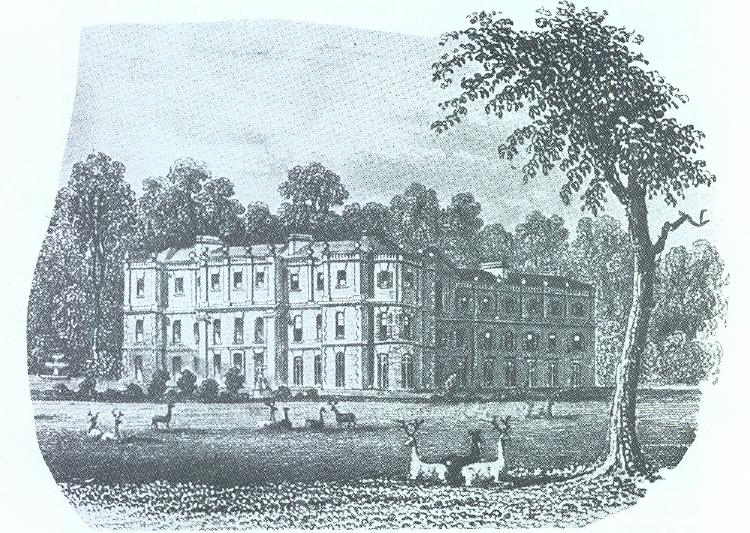
The Grove in 1861 (Watford Museum / Hertfordshire Library Service)
Shortly after acquiring the estate Thomas Villiers commissioned an architect to make alterations. According to notes in Watford Reference Library, The Grove was built in 1756, by Sir Robert Taylor, enlarged about 1780 and again in 1786. While he was a student at Magdalene College, Cambridge in the 1960's, Marcus Binney produced fairly conclusive evidence that this was unlikely. Binney attributes the 1756 alterations to Matthew Brettingham, who lived between 1699 and 1769. His account book, now in the Public Records Office, confirms that he worked at The Grove at that time. According to Smith's report, building work, not specified in detail, was going on from 1754 to 1761. This is confirmed in correspondence between Mr Hassell of The Bodleian Library, Oxford, and Mr. Whitfield, of The Hertfordshire County Records Office. From records held at Oxford we know that £169 was paid to brickmakers, £214 to bricklayers and £58 to Mt. John Cuenot, a carver.
According to the book 'Walpole - Ancedotes of Painting', Taylor carried out Lord Clarendon's alterations in Herts.
In 1966 Marcus Binney attended a meeting at The Grove during which Mr. R. Mortimer, then a member of The Grove staff, made notes. Binney told the meeting that Sir Robert Taylor (1714-88) made substantial alterations and additions about 1780. This work almost certainly consisted of the present front hall (which was probably then a chapel). When Ron Brown was featured in the 'Watford Observer', he told reporter Jean Groome, "when we came here in 1957, they decided to do some alterations. They took down some plaster in the front hall and discovered a font in the wall. I saw it. It was pale blue and was left uncovered for a few weeks. The wall is three feet thick in that place". In addition to the front hall, Binney told the meeting, that the front classroom, general offices and library were added at that time. The top storey was also added. Cussan confirms this information in 'History of Hertfordshire', as did the authors of the book 'Hertfordshire - Some Ancestral Estates and Interesting Careers'.
Binney then proceeded to tour the building, outlining various features. In Lecture Room 1 the fire place and doors were almost certainly of Taylor design, and dated around 1780. Much of the ceiling is original, though the cross beams and the freize below the cornice may be later additions. The present Principal's office was most probably the original entrance, leading straight into the 20th Century main corridor. In the library, apart from the fire place and the bookshelves which are original, the remaining features are later additions (circa 1875). The staircase is not of Taylor design, these being usually of open plan construction. The Grove staircase may well be late 19th Century. In the lounge the fireplace and doors are probably of 20th Century construction. In a letter to The Grove, Binney refers to the library fireplace being identical to one at Harleyford Manor, Great Marlow, Bucks, which was another of Taylor's works. This was referred to in an article on 'The Villas of Sir Robert Taylor', written by Marcus Binney and published in Country Life magazine. This appears to invalidate earlier claims that Taylor was responsible for the 1756 alterations. The esteem in which Taylor was held is shown in a monument to him at Westminster Abbey, London. This bears the inscription "His works entitle him to a distinguished rank, among the first class of British architects".
The Grand Junction Canal (now known as The Grand Union Canal, and part of The British Waterways Board) passes within the estate boundaries. Work began on it in 1793, and it opened for business, as far as Braunstone in Northamptonshire, in 1800. The main drive crosses the canal on its way from Hempstead Road to the mansion. It is worth noting that the present drive was not the main drive at this time. That ran from Grove Mill Lane due south, to the then main entrance. The canal bridge has its own architectural interest, and is a grade two listed building. No doubt the Earl was well rewarded financially, for allowing the peacefully flowing canal, which ran on the course of the River Gade, to pass through his lands, albeit on his own stringent conditions.
When railways became a serious form of transport in the 1830's the London & Birmingham Railway was interested in following the same course along the Gade valley. While the Earl was prepared to tolerate quiet and slow moving canal barges he was not so keen on dirty, noisy steam locomotives polluting the estate. The only choice left to the railway company was to seek an alternative route to the east of the estate, which explains the need for the lengthy and expensive Watford tunnels. He was, no doubt, relieved to have escaped from the advances of the railway company, but one cannot help wondering what the Earl's reaction would be to his ancestral home being used as a training centre for railway managers!
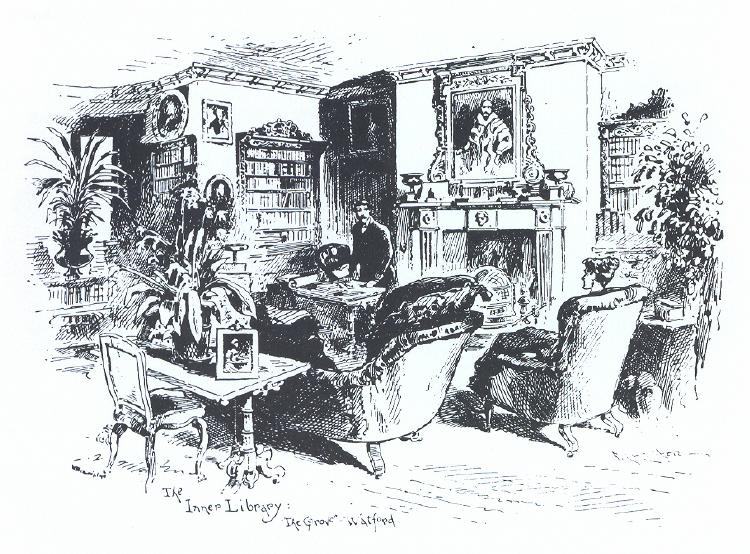
The present lounge in earlier guise (Grove Collection)
The third phase of building, took place about 1875. Marcus Binney describes this work as follows;
"About 1875, there were further alterations and additions, probably by Edward Blore (1787-1879). He was probably responsible for the lounge wing. It should be noted that this wing copies the 18th Century structure, even to the reproduction of the cornice motives, but is, nevertheless, inferior in both quality of design and room proportions."
Just to confuse us all, one exterior brick is inscribed 1779!
On the death of the first Earl in 1786 the title passed to his son, Thomas Villiers, who had been born in 1753. He did not marry and therefore had no direct heir to succeed him. On his death, the title passed to his brother, John Charles Villiers (1757-1838). He had been educated at St. John's College, Cambridge and graduated as a Master of Arts. He was made Kings Counsel in The Duchy Of Lancaster, by his father, who was Chancellor Of The Duchy, and was also made controller of the Kings Household. He sat in Parliament from 1790 until 1802, as M.P. for Dartmouth. Afterwards he sat for the Wick District of Burghs, before accepting The Chiltern Hundreds. From 1794 he was a Colonel of the 1st Regiment of Fencible Cavalry, later holding the same rank in the Army. He died on December 22nd 1838, and is buried in Watford.
According to 'History of Watford', he was succeeded by George William Frederick Villiers (1800-75), who became the fourth Earl in 1838. He was a diplomat, and, at the age of twenty, was an attache to The British Embassy in St. Petersburg, Russia. He was involved in matters between England and Ireland (1827-9), and between England and France (1831). This led to an appointment in Madrid, Spain in 1833, for which he was honoured, on the recommendation of Lord Melbourne, receiving the GCB He was later appointed Lord Lieutenant of Ireland, which, even at that time, was a difficult position. Queen Victoria honoured him with the Order Of The Garter and unusually, allowed him to retain his Insignia Of The Bath, because "he merited both distinctions". Lord Clarendon was Foreign Secretary three times, in 1853-1858, 1865-1866 and finally 1868-1870.
On the death of his father, Edward Hyde Villiers (1846-1914) became the 5th Earl Of Clarendon. He served as ADC to Queen Victoria, and later to King Edward VII. The King visited The Grove in 1909, a year before his death. Photographs of this event were taken by F Downer & Sons, Watford. The Earl contested the South Warwickshire parliamentary seat in 1868 and was unsuccesful. He became Liberal Unionist MP for Brecon in 1869. He was appointed Lord Chamberlain in 1900, a position he held for five years. According to 'History of Watford', "his last appearance in public, showed how wide his interests were, and how faithful his expression of them. During the early part of The Great War, he visited The St John Ambulance Brigade, who were on drill at St John's Hall, London. Though frail, and bearing the marks of a sick man upon him, he spoke a few words of encouragement and appreciation, and withdrew. A few weeks later he passed away, and was laid to rest in a sylvan sanctuary of his own choosing, in his own grounds". His grave has a double headstone, but only one side (the right hand) bears an inscription. It is assumed that this was to have been a double grave, but for some reason was not used as such. A monument erected by his son (the 6th Earl), stands close by.

The old monument and headstone to the fifth Earl in the woods
near to the walled garden (R Heasman)
George Herbert Hyde Villiers (1877-1955), became the 6th Earl. Whilst at Eton he broke his hip, spending a considerable amount of time in hospital. The disability which resulted was said to have upset his father, who had visions of him playing for Middlesex County Cricket Club, an education at Oxford and a career in the Royal Horse Guards! It certainly brought an end to his promising athletic career. According to his obituary in The Times (1955), "he was an extra ADC to The Lord Lieutenant Of Ireland. A Conservative in politics, he was Chancellor Of The Primrose League from 1919-21. He then became Lord in Waiting to the King, and was then appointed Parliamentary Under Secretary for Dominion Affairs, and Chairman of The Overseas Settlement Committee. From 1927-30 he was Chairman of The British Broadcasting Corporation (BBC). In 1930 Lord Clarendon was appointed Governor General of South Africa and sailed there in January 1931 to take up his post. He lived up to every expectation, and made it his duty to know every part of the Union. He and Lady Clarendon identified themselves with beneficent works and social services of every kind. In 1935, he suffered a grievous loss in the death of his eldest son, Lord Hyde, as a result of a shooting accident. On the news of this tragedy, a wave of spontaneous sympathy swept over the Union. When, in the same year, his term of office was extended, the result was received throughout South Africa with keen satisfaction. During his term of office he had seen the Union pass through a lean and difficult period, which followed the world depression. When he left it, in 1937, it was enjoying great prosperity. Before he sailed the South African Prime Minister expressed 'the appreciation of the Goverment and the gratitude of the people' for the way in which they had sought to advance the national harmony, in a spirit of impartial devotion to duty. On returning to London he was created a Knight Of The Garter". An autographed photograph taken of Lord Clarendon at this time appeared recently in the magazine 'South African Panorama'.
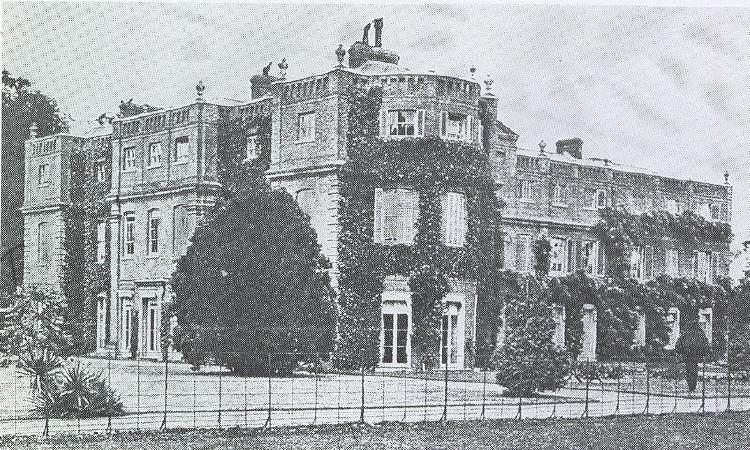
The Grove in the latter days of Clarendon Ownership (Grove Collection)
On his return he became Lord Chamberlain and also Chancellor Of The Order of St John of Jerusalem. During his term of office much of the ceremonial side of The Lord Chancellor's work was reduced by the outbreak of the Second World War.
'The Times' obituary continued, "he will perhaps be most vividly remembered as Lord Chamberlain for his courtesy, for his fine voice, which sounded particularly impressive at investitures, and for the dignity and fortitude, with which he overcame lameness".
He performed his duty as Lord Chamberlain at the funeral of King George VI and resigned on medical advice shortly afterwards.
It was during the 6th Earl's life that The Grove was sold. In 1922 he moved to Hampstead, London. This move brought to an end the family's long association with The Grove.
The present Earl, the 7th, was born on February 2nd 1933 and now resides in London SW3. In 1979 he granted The Grove permission to use the family crest in the design of The Grove tie.
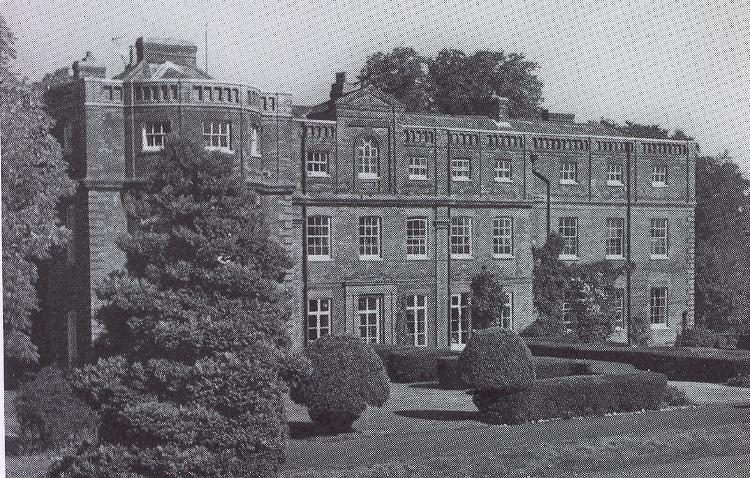
The Grove from the south. Original entrance was below portico (BRB)